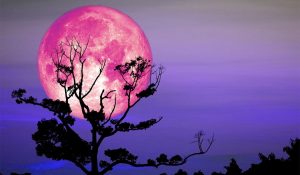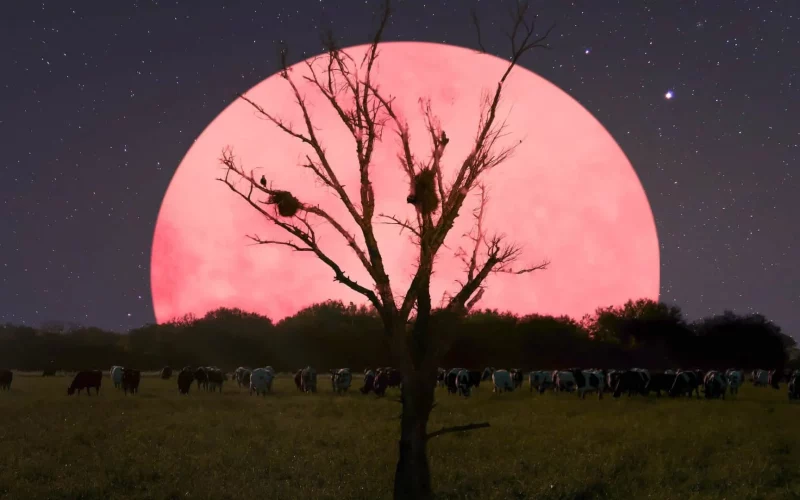As April’s full moon graces the night sky, its luminous glow promises a captivating spectacle for skywatchers around the world. Despite its name, the moon won’t shine pink tonight, but its radiant golden hue still offers a sight to behold. Observers can start witnessing this lunar event on Wednesday night, with its peak expected in the early hours of Thursday morning at 12:34 a.m. ET.
Importance of Observing the Moon
Dr. Noah Petro, chief of NASA’s planetary geology, geophysics, and geochemistry lab, emphasizes the significance of each full moon, encouraging people to appreciate its beauty and understand the lunar phases better. While the April full moon may appear similar to others at first glance, Petro suggests taking a closer look through binoculars or telescopes to observe the moon’s intricate features and varying rock compositions.
A Closer Look: Observing the Moon’s Features
By examining the moon’s surface, observers can discern different colors and formations, reflecting the diverse geological composition of lunar terrain. Petro’s recommendation to use binoculars or telescopes underscores the importance of experiencing the moon’s majesty up close, fostering a deeper appreciation for Earth’s celestial neighbor.
Moreover, understanding the geological features of the moon enhances our knowledge of its formation and evolution. For instance, the presence of craters, mare (dark areas), and highlands provides valuable insights into past lunar impacts and volcanic activity. Petro’s encouragement to explore these features not only enriches our understanding of the moon but also fuels curiosity about the broader cosmos.
Optimal Viewing: Tips from NASA

For optimal viewing, Petro advises finding a location with minimal light pollution and a clear view of the night sky. This allows observers to fully immerse themselves in the celestial display and appreciate the moon’s splendor. Additionally, Petro highlights the presence of Venus and Mars near the moon, enhancing the astronomical panorama for eager skywatchers.
Moreover, NASA’s continuous efforts to expand lunar exploration through the Artemis program add another layer of excitement to observing the moon. With plans to establish sustainable human presence on the lunar surface, including the Artemis Base Camp, there’s a renewed focus on studying the moon’s resources and potential for scientific research.
Origins of the Pink Moon
While the April full pink moon won’t appear pink in color, its name pays homage to the vibrant blooms of spring. The term “pink moon” is derived from the hot pink wildflower Phlox subulata, which carpets the landscape with its vivid hues during the spring season. Native to eastern North America, this wildflower symbolizes the renewal and abundance of nature as it heralds the arrival of spring.
The association between lunar events and seasonal changes reflects humanity’s deep connection with nature and the cosmos. Throughout history, civilizations have marked celestial phenomena like full moons with cultural significance, incorporating them into rituals, folklore, and calendars. The “pink moon” serves as a reminder of this age-old tradition, celebrating the harmony between Earth’s cycles and the lunar phases.
Looking Ahead: Lunar Events and Beyond
Beyond April’s full moon, skywatchers can anticipate a series of celestial events throughout the year. With nine more full moons on the calendar, including two supermoons in August, there are ample opportunities to marvel at the lunar cycle and its cultural significance.
In addition to full moons, 2023 offers a lineup of eclipses and meteor showers for avid stargazers to enjoy. From the spectacle of a total solar eclipse to the ethereal beauty of meteor showers streaking across the night sky, each event offers a unique opportunity to connect with the cosmos and appreciate the wonders of the universe.
Furthermore, ongoing advancements in astronomy technology continue to enhance our ability to explore and understand the cosmos. From ground-based observatories to space telescopes like the James Webb Space Telescope, humanity’s quest to unravel the mysteries of the universe knows no bounds. As we look to the future, the possibilities for discovery and exploration are limitless, inviting us to journey further into the depths of space.
Conclusion
As we gaze upon April’s full moon and the celestial wonders that lie beyond, let us embrace the beauty of the cosmos and marvel at the intricacies of the universe. Whether observing the moon’s craters through a telescope or counting shooting stars during a meteor shower, each moment spent under the night sky offers a chance to connect with the vastness of space and the wonder of exploration. So, let us raise our eyes to the heavens and celebrate the magnificence of the cosmos in all its splendor.
FAQs
Is the April full moon actually pink?
No, despite its name “Pink Moon,” it doesn’t appear pink. The name is derived from the pink wildflower that blooms during spring.
What is the significance of observing the moon’s features with binoculars or telescopes?
Using binoculars or telescopes allows observers to see the intricate details of the moon’s surface, enhancing their appreciation for its beauty and contributing to scientific understanding.
How can I find the best location for observing celestial events?
Look for areas with minimal light pollution and a clear view of the night sky. Parks or rural areas are often good choices, and there are also online resources and mobile apps available to help locate optimal viewing spots.
What other celestial events can we look forward to besides full moons?
Throughout the year, there are eclipses, meteor showers, planetary alignments, and other phenomena to enjoy. These events provide opportunities for both amateur and professional astronomers to engage with the cosmos and deepen their understanding of the universe.
Why is understanding lunar phases important?
Understanding lunar phases helps us grasp celestial mechanics better and appreciate the rhythms of the universe. It also has practical applications, such as in agriculture and navigation, and has been significant in various cultures’ calendars and traditions.










